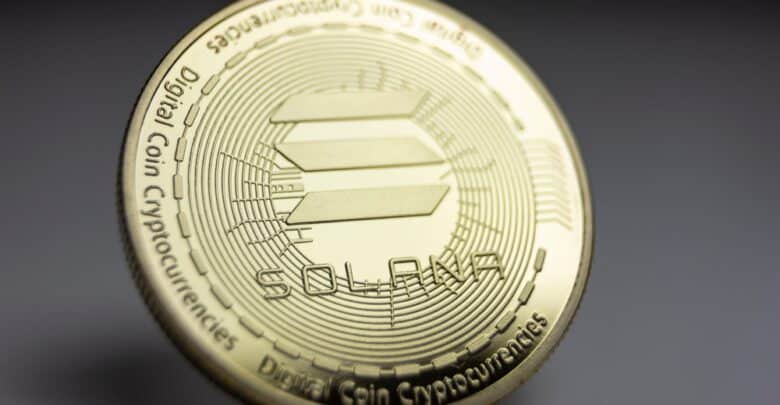
With its Introduction in the year of 2017, Solana is known to have excelled in the crypto space, managing to gain a position in the list of top level blockchains, mainly due to its open-source nature. From the beginning, Solana has been in line with the Proof-of-Stake (PoS) consensus which provides its community the opportunity to submit tokens via the smart contract technology and then later gain beneficial returns out of it.
Moving forward, will now discuss a bit about Solana and then proceed to understand how and where it can be staked.
About Solana
As previously mentioned, Solana is basically a blockchain and is open source in nature. The good thing about Solana is that it takes advantage of the smart contracts system, making it highly efficient when it comes to transaction processing and giving power to crypto-based platforms and decentralized finance (DeFi) products and services. In addition to the proof-of-stake concept, Solana also gains power from the Proof-of-History concept, which helps it to process the smart contracts.
The validators involved are incentivized with different benefits that are mainly figured through a mathematical term known as annual percentage yield which is quite like how interest works. The involved validators and individuals that take part in the staking of Solana’s native token SOL are the ones who receive the benefits.
Now that we have a basic understanding about Solana, we will move towards how individuals can stake Solana.
Staking Solana
The individuals who possess the native Solana token SOL can take part in a staking mechanism, which requires them to submit their native tokens towards a node. The individuals can perform this task either using self-owned servers or trusting pools from other users that are looking towards the same motive. By doing so, the investment put into by the individuals helps in the development of the network, so they are rewarded with incentives according to a set rate.
Because of its capabilities, there is a lot of competition that is involved in terms of the benefits being distributed and the overall system in general, marking itself as quite an attractive option for those who are seeking to earn out of the activity of staking. According to data taken from multiple sources, due to its popularity, Solana is recognized as one of the best in terms of staking, having a total amount submitted to be around 44 billion currently.
However, due to its immense level of popularity, the rewards received from staking Solana can be quite underwhelming when compared to other chains like Ethereum and Cardano, which have a much more attractive yield level.
There are different aspects that contribute towards the total reward that is to be provided to the ones who stake Solana. The total reward given out is mainly dependent upon three things, the platform utilized, the staking technique and the number of native SOL tokens being staked. The annual percentage yield resulting from staking Solana falls between the percentages of five to seven percent, however this value maybe different for other platforms.
The aspects that have an influence over the interest rate for Solana staking include the number of tokens already staked, the charges that are placed by validators and the inflation rate on SOL.
To better understand this, we can look at an example. Suppose the investor submits around ten thousand native Solana tokens with an annual percentage yield of around 6 percent, this means that they are possibly able to receive around 600-700 SOL by the concluding year. Please note that this example only includes estimates, and the original values might be different, depending upon the factors mentioned above.
Working Behind it
In this section, we will understand the behind the scenes of how all this staking operation works. The Solana blockchain networks make use of a validation system that is needed to process different transactions. Because the concept of Proof-of-Stake surrounds the operation, it is said to much more feasible and has a way lesser carbon footprint in comparison to the Proof-of-Work concept that is followed by blockchains like Bitcoin.
Individual that has submitted tokens onto the network, are supposed to manage a node, which is basically a server, that is chosen on random to process the transactions over at Solana. Alongside that, Solana also has the Proof-of-history concept by its side, which is basically used to figure out the order in which the different transactions are to be confirmed, helping the system to become more efficient when handling millions of transactions across the network.
With all that out of the way, lets see how you can start to stake Solana in the next section of this article.
Procedure of Staking Solana
The process of staking Solana can be done in many unique ways, each having a different level of working to them.
- Staking Via an Exchange
This is said to be one of the most trivial ways of staking Solana and does not involve any complex set of steps. Firstly, you will have to select an exchange that supports staking on Solana, like Binance and you will need to make a full account on it as well. After that you must acquire SOL tokens by buying or trading through Binance and then proceed to transfer the tokens in your Binance wallet.
Then go to the staking section and search for SOL from the dropdown, then enter the submission time and the number of SOL tokens you are looking to stake and then click the “Stake Now” button to complete the process. Now to receive the rewards, you will have to wait till the submission time has been fulfilled.
- Staking Via a Direct Wallet
This method is a bit more tedious in comparison to the one involving the exchange. You will have to discover a good validator in order to assign the native tokens onto a pool. You must be careful when choosing a validator and must make sure that the validator is legit in order to get rid of any sort of unwanted risk. There are a few aspects you can consider when getting hold of a validator.
First is the amount of uptime in which if validator possesses are lower uptime, then there is a big chance that the validator will be excluded from the network, so it suggested to look for validators with a complete uptime.
Next up is the number of individuals that are associated with that validator, the higher the number of those individuals, the more trustworthy it may seem to be. The advantage of having an independent validator is that the number of returns is far greater, and this also contributes towards the decentralization of the entire network.
And lastly, there are the charges that the validator will require you to pay based upon the rewards that have been received in staking.
The main advantage behind using a separate wallet to stake is that even of the native tokens are submitted onto the network, you will still have full access to the assets, meaning that it will reduce the risk of you being subject to an attack, compared to that of the exchange method. According to sources, the most popular wallets to stake Solana are said to the Phantom and the Solflare wallet, each of them having their own set of perks for the users to take advantage of.
Risks Surrounding Solana Staking
As with almost any other method of earning, there is always a risk factor that must be kept in mind before getting into the action. Solana might be seen as one of the best ways to make an earning through the method of staking, however it is not safe from the risks. Individuals looking to stake must be careful of the aspect of slashing.
Seen as negative aspect, slashing happens when the validator involved in the node is performing some shady operation or is not inline with the recommended uptime on the network. Because of this, there is a big chance that the validator might lose a significant amount of the returns and in some severe cases, even all of them. In general, when the validator fails to deliver the returns and is slashed, then the individual that invested in the staking will also lose their money.
Solana Staking Returns Record
Solana gained its massive popularity back in the end of the year 2020, resulting in the valuation hike of more than 24,000 percent versus USD recorded in the end of last year. In that time, the annual percentage yield for staking Solana native tokens had reached an impressive 50 percent and as of now, that percentage currently stands at 6 percent that is still quite an impressive yield level which can assist investors in dealing with the volatile market.
Solana Staking Venues
As previously mentioned, Solana can be staked either through an exchange or just using a direct wallet. Majority of the users, mostly new players prefer an exchange by their side to help them in the staking process. Staking through an exchange is quite a trivial method, so new investors looking to stake Solana have a much easier path set for them.
We will now take a close look at some popular cryptocurrency exchanges that provide their users with the chance to stake Solana tokens and then earns returns out of it.
- Binance
This exchange is at the top of cryptocurrency exchanges worldwide when it comes to the level of popularity, mainly due to the level of success it has managed to gain from the plethora of features and services it provides that include different money-making solutions, powering NFT trading platforms and the option to perform derivative trading.
Back in the start of last year, the Binance exchange was known to be the preferred exchange, when it announced the Solana staking feature. The main highlight was the massive annual percentage yield, recorded to be around 43 percent, which was massive and obviously attractive for investors looking to get into the work.
That yield percentage has dipped with the passage of time, but Binance is still a great option as it is still in the competition and is friendly for new players in the sector. Submission time on Binance can go up more than 3 months and the more time the tokens stay submitted, the more amount of yield is produced. Recently recorded yields have reached to a maximum of around 13.4 percent, making Binance the go-to option for many investors in the space.
Coinbase is one of the latest exchanges to join the train of Solana staking. The exchange announced Solana staking in the month of June this year. Coinbase also falls into the list of top trending cryptocurrency exchanges, so the addition of Solana staking onto the platform provides many individuals to perform staking without having to go through mind bending procedures as seen with direct wallet staking.
Solana staking on Coinbase has a few incentives that are quite attractive. Firstly, investors staking Solana on Coinbase will receive their returns after a couple of days every week. Secondly, Coinbase allows a minimum investment of $1, which makes it great for new players looking to learn the process. And lastly, individuals have the power to pull out their assets during any given time of the process, so it is a great way for individuals to maintain their power over the assets.
As of now, the annual percentage yield of staking Solana sits at less than 4 percent, which can change depending upon how the market goes on. Another thing to note is that Coinbase charges 25 percent as staking charges, so that must be kept in mind.
FTX made its entry into the scene back in 2019 and has showed a consistent level of popularity and is known for its spot and crypto futures trading features. The impressive thing for Solana is that it has managed to make its way onto the FTX staking list, as that list only has four other tokens.
The thing to keep in mind with FTX is that the US version of FTX is not supportive of staking despite having the option of funds exchange, however international users can benefit from the impressive annual percentage yield of 6 percent with the rewards being distributed almost daily. Keep in mind that there is a 10 percent charge for pulling out tokens. Because of this staking Solana on FTX is not suitable for new players.
Kraken is also one of those platforms that is suitable towards both experienced and new investors seeking to stake Solana, mainly because of its trivial process. The exchange offered Solana staking in the mid of last year and it seen to be quite a consistent and trusted platform, despite its UI which does not reflect a more modern and trendy style. Kraken also has a similar annual percentage yield that sits around 6 percent and more.
The platform has no charges for pulling out tokens early, as it does not have a set submission time.
This platform has made it name in the crypto sector at a rapid pace, from obtaining rights for sports venues to getting associated with the massively popular football club known as PSG. Staking Solana on Crypto.com is a breeze because of its automated staking option, which when triggered proceeds to generate staking benefits for the user.
The annual percentage yield of around 2 percent might seen low to many, however this can be boosted by subsequently staking CRO tokens, but if CRO tokens are involved, then the investment level becomes too high for new players, because of the hefty requirements. A major setback here is that the lowest level of Solana that can be staked is five, again making it difficult for new players.
This exchange has had quite a history to its name. Launched back in the year of 2013, the exchange has managed to develop an outstanding level of popularity, as its operations are spread across many regions such as the US, ASIA and many other regions. Houbi provides an annual percentage yield of around 3.5 percent and gives users five days to pull token if needed so.
Houbi also conducts different events in which individuals can get their hands on SOL tokens for free, boosting the annual percentage yield to more than 50 percent in some cases, making it an amazing option for many. Houbi might not be amongst the top, but individuals can surely take advantage of the opportunities it brings to obtain the best returns possible.
Final Thoughts
Staking Solana is one of the many good ways of making money from your investment. With exchanges providing trivial ways for individuals to make returns, the process can be easy and beneficial for both new and experienced players in the market. Not only that, but individuals using wallets to stake can boost their returns even further, reaching the dream yields that they desire, helping them to earn big from their precious investments onto the Solana Network.
Staking Solana can also act as a contribution towards the development of the overall blockchain and network, so staking is encouraged by many, making the entire system reach new levels of decentralization.
Tokenhell produces content exposure for over 5,000 crypto companies and you can be one of them too! Contact at info@tokenhell.com if you have any questions. Cryptocurrencies are highly volatile, conduct your own research before making any investment decisions. Some of the posts on this website are guest posts or paid posts that are not written by Tokenhell authors (namely Crypto Cable , Sponsored Articles and Press Release content) and the views expressed in these types of posts do not reflect the views of this website. Tokenhell is not responsible for the content, accuracy, quality, advertising, products or any other content or banners (ad space) posted on the site. Read full terms and conditions / disclaimer.







